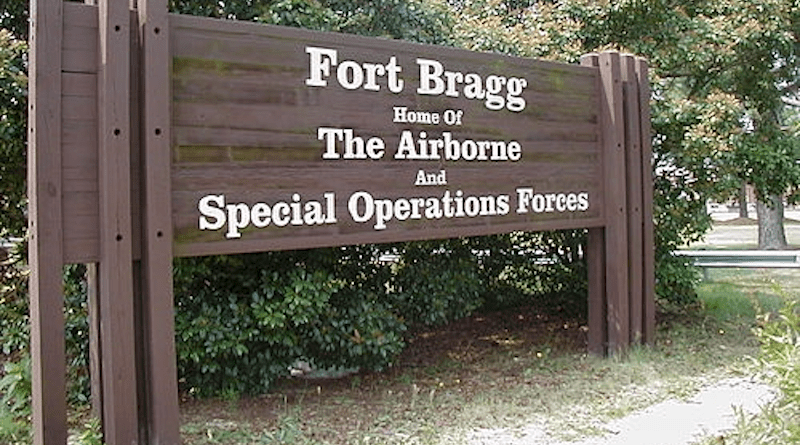Pentagon Begins Implementing Naming Commission Recommendations Replacing Confederate Names
By DoD News
By Jim Garamone
So long, Fort Bragg. Hello, Fort Liberty.
The Naming Commission process is now over and the names of bases, posts, ships, streets and more named after Confederate soldiers will change.
William A. LaPlante, the undersecretary of defense for acquisition and sustainment, directed all DOD organizations to begin full implementation of the Commission on the Naming of Items of the Department of Defense recommendations. LaPlante acted at the end of a 90-day waiting period that began after the Naming Commission released its third and final report in September.
Secretary of Defense Lloyd J. Austin III accepted the renaming recommendations in September.
The services and other DOD agencies have until the end of the year to complete the process.
Retired Navy Adm. Michelle Howard chaired the congressionally mandated Naming Commission. The commission’s mission was to provide removal and renaming recommendations for all DOD items “that commemorate the Confederate States of America or any person who served voluntarily with the Confederate States of America.”
While Army bases are the most conspicuous examples, many installations have street names or buildings named after Confederates. Even Arlington National Cemetery in Virginia has a large Confederate Memorial, which is now being disassembled. The Navy will rename the cruiser USS Chancellorsville, which commemorates a Confederate victory, and the USNS Maury — named after a U.S. Navy officer who resigned his commission to fight for the Confederate Navy — will also be renamed. Battle streamers commemorating Confederate service will no longer be authorized.
Some Army bases, established in the build-up and during World War I, were named for Confederate officers in an effort to court support from local populations in the South. That the men for whom the bases were named had taken up arms against the government they had sworn to defend was seen by some as a sign of reconciliation between the North and South. It was also the height of the Jim Crow Laws in the South, so there was no consideration for the feelings of African Americans who had to serve at bases named after men who fought to defend slavery.
All this changed in the aftermath of the police killing of George Floyd in 2020. Many people protested systemic racism and pointed to Confederate statues and bases as part of that system. Congress established the commission in the National Defense Authorization Act of fiscal 2021. Then-President Donald J. Trump vetoed the legislation because of the presence of the commission, and huge bipartisan majorities in both houses of Congress overrode his veto.
The commission issued its first report in May 2022, which addressed renaming Army bases. The commission finished their mission on Oct. 1, 2022 and there was a 90-day period for public comment. That has now expired and the renaming of the bases may proceed apace.
Fort Benning, Georgia, will be renamed Fort Moore after Army Lt. Gen. Hal Moore and his wife, Julia Compton Moore. Moore commanded U.S. forces in the first large-scale battle of the Vietnam War. His book — “We Were Soldiers Once…And Young” was made into the 2002 movie We Were Soldiers.
Fort Gordon, Georgia, is renamed Fort Eisenhower after General of the Army Dwight D. Eisenhower, the leader of the liberation of Europe in World War II, and the 34th president of the United States.
Fort A.P. Hill, Virginia, is renamed Fort Walker after Dr. Mary Edwards Walker — the first woman surgeon in the Civil War, and the only woman awarded the Medal of Honor.
Fort Hood, Texas, is renamed Fort Cavazos in honor of Army Gen. Richard E. Cavazos, a Hispanic-American hero of both the Korean and Vietnam Wars.
Fort Lee, Virginia, is renamed after two soldiers and will become Fort Gregg-Adams. Army Lt. Gen. Arthur J. Gregg was an African-American soldier who rose from private to three-star during a career in military logistics. Army Lt. Col. Charity Adams was the first African American officer in the Women’s Army Auxiliary Corps in World War II and led the first African-American WAAC unit to serve overseas.
Fort Pickett, Virginia, is renamed Fort Barfoot in honor of Army Tech Sgt. Van T. Barfoot, who received the Medal of Honor for his actions with the 45th Infantry Division in Italy in 1944.
Fort Polk, Louisiana, is renamed Fort Johnson to commemorate Army Sgt. William Henry Johnson. Johnson was a member of the famous Harlem Hellfighters that fought under French Army command during World War I. Johnson belatedly received the Medal of Honor for an action in the Argonne Forest of France where he fought off a German raid and received 21 wounds in the hand-to-hand fighting. President Barack Obama awarded Johnson the medal in 2015, long after the soldier died in 1929.
Fort Rucker, Alabama, is renamed after Army Chief Warrant Officer 4 Michael J. Novosel. The chief was an aviator who flew combat in both World War II and Vietnam and received the Medal of Honor for a Medevac mission under fire in Vietnam where he saved 29 soldiers.
Finally, Fort Bragg, North Carolina, is renamed Fort Liberty

